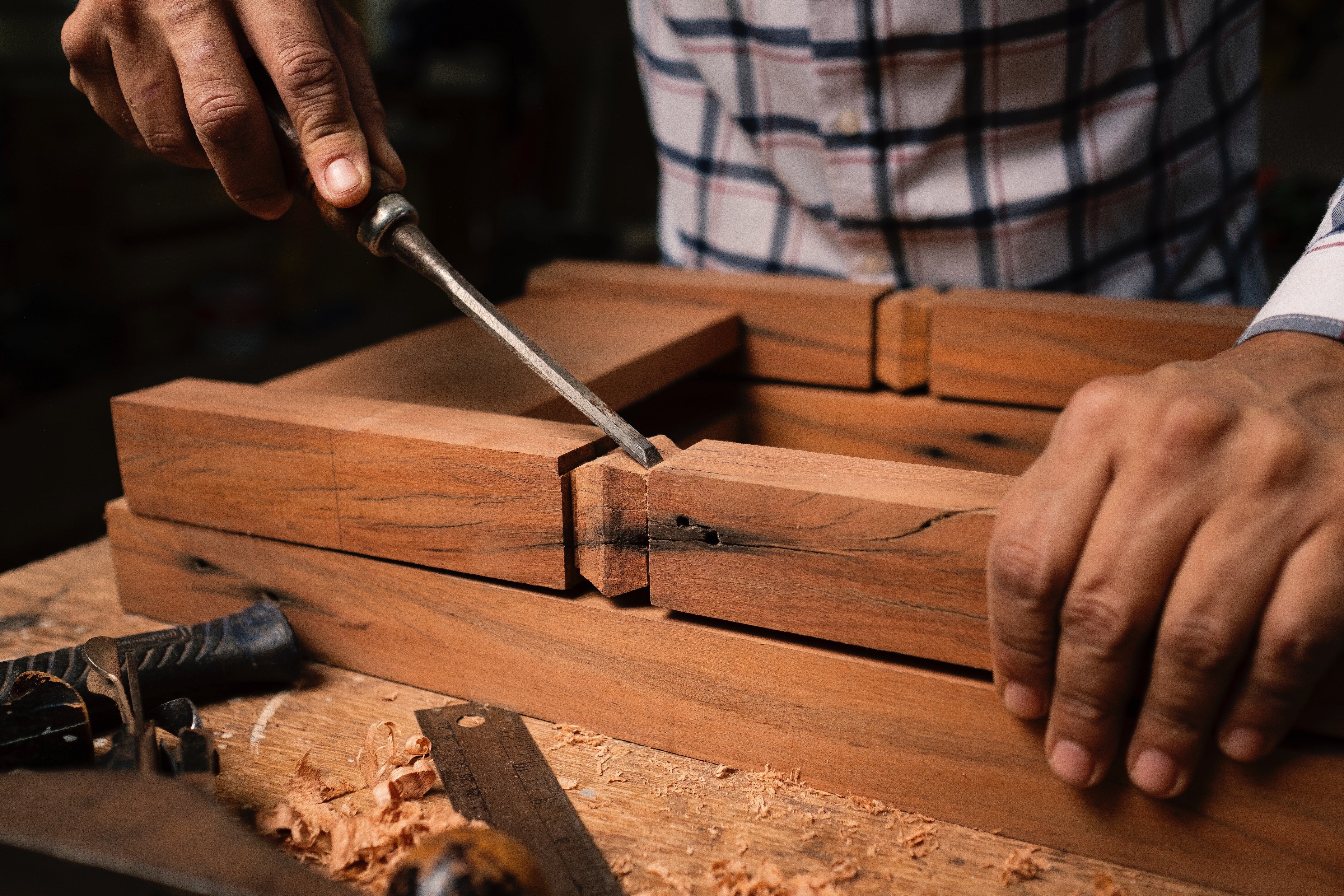23 Things I Wish I Would Have Known as an Amateur Woodworker

Woodworking is a rewarding hobby, but it is not without its difficulties. We at Open Door Furniture have compiled a list of 23 things you need to know if you're just beginning your journey in woodworking. We hope that you can learn from some of our (and many others) early mistakes and flourish in your own ambitions as woodworkers.
- Safety is important – Every woodworker has their scars; it is an unavoidable part of the trade. What we can and need to do is minimize our injuries in the woodshop. Woodworking will be a lot less enjoyable with a finger or two missing or if we can no longer hear the call for dinner. To be safe in the shop you need to be proactive. Read your tool manuals and watch safety videos when you get a new tool, wear eye and ear protection when working with power tools and take dust management measures. If you care for your personal safety, you can enjoy woodworking as a lifetime hobby.

- Wood dust is hazardous – Overexposure to wood dust can cause the woodworker to become allergic. In the most severe cases, allergies can cause the woodworker to have to give up their trade and find new means of work or enjoyment. Even worse than the potential allergy risk, wood dust poses a cancer risk as it is a carcinogen. When sanding or milling, it is important to an individual’s long-term health and viability to install a dust collection system or wear a facemask when milling and sanding.

- Make a detailed and complete plan – It is often more exciting to build a project than it is to plan one. That being said, it is important to complete your project plans before you ever make your first cut. Plans can be made by hand, or they can be purchased or found online. Projects that are put together without having completed a plan often tend to encounter design problems in the final stages of the building process.

- Account for wood movement – One of the biggest things that sets apart craftsman from amateur woodworkers is their understanding of, and planning for, wood movement. Wood expands and contracts with seasonal humidity changes and if not accounted for, may cause your project to fail. There are many variables that account for different rates of expansion and contraction such as wood species, thickness of material, where the project is placed when completed ect. and a woodworker needs to understand and account for all these variables. A general rule of thumb is do not in any way inhibit woods expansion or retraction across the grain without taking special precautions for wood movement.

- Execute proper joinery techniques – There is nothing more discouraging in woodworking than when a project falls apart. Unfortunately, this is the risk we run when we don’t use proper joinery practices. No matter what you use for your joinery be it glue, mechanical connections (screws bolts ect.) or traditional wooden joinery, it is important to know how that joinery works and execute it appropriately.

- Tape measures are not accurate for percise measurements – tape measures are designed with a loose hook on the end in order that they can give accurate measurements both when the tape is pulled across a surface or pressed into a corner. Because of the loose nature of the hook, tape measures are never perfectly accurate. When you need a precise measurement that is longer than your wooden or steel rule, line the edge of your piece on the 10in mark. After you’ve made your measurement, subtract the 10in and you’ll get your exact measurement.

- Account for your pencil width when making a cut – A pencil line can be 1/16 of an inch thick or more. That may not seem like a lot, but in woodworking terms that can make a joint loose or cause a gap. When you are making a cut off a pencil line, cut to the edge of it, not the whole thing. It is better to be a little long than a little short. A piece that is a little long can be cut again, but there is no tool to stretch wood.

- Sanding is not milling - It is a common misconception that most of the shape manipulations in woodworking come from sanding. This is not the case. Unless you are doing some sort of curves or carving that require a special process, sanding should be kept for the end of a project and done as minimally as possible.

- Save your sanding for the end – Although it is tempting to sand small problems as they arise (dents, scratches, ect.) save all the sanding for right before you begin the finishing process. This will avoid wasting time and will help keep your project looking sharp. Too much sanding can lead to a surface that is not flat or details that are “muddy”.

- When sanding, go through the grits – When you begin the sanding process, it is important to go up the sanding grits. If you start at #80 and want to finish at #220, you need to have two more grits in the middle, maybe #120 and #180. At Open Door, we move up the common grits (#60-#220) in increments of 60 or less. Although this may appear to take longer, it is a much shorter process as you are working out the scratches made by the rougher sandpaper more incrementally.

- Sanding to high grits (320 and higher) is often a bad idea – There is a misconception in woodworking that the higher grit you sand, the better your results. Although this is marginally true in pure oil finishes, it can cause bonding issues with most finishes. Be sure to read the manufactures instructions on the can of finish before you start sanding, and work to their specifications.

- Break your edges – It is a simple step that is often forgotten. When you are handling your project, be sure to gently sand down the sharp edges. It might not seem like much, but it will keep you from accidently blowing out an edge.

- Stain is not a finish – Applying a finish is the last step in the building process. There is a misnomer in woodworking that stain is a finish. It is not, anything stained will need a clear coat of varnish, polyurethane, or lacquer in order to seal it. Stain is used to primarily to color the wood, nothing else.

- Do not mix oil and water stains/finishes – This mistake has ruined more than a few good woodworking finishes. Oil and water do not mix as finishes, and when you put an oil-based finish over a water-based stain or vice versa, they probably won’t bond (possible after a long cure time, but still not recommended). Be sure to read and follow the finishing directions on your can of finish.

- Good finishing practices are just as important as good building practices – In production shops, “the finisher” is one of the most skilled workers on staff. A good finish job can hide a lot of mistakes in a project and thus elevate it. A bad finish job can ruin otherwise perfect projects. As an amateur woodworker developing your skills, do not neglect to learn about finishing as it will have a big contribution to the end result of your project.

- Read your tool manuals – There is nothing more frustrating than not knowing how to use a tool, or not being able to use it well. Reading your tool manuals is important as you can get a better idea of what you are using, the dangers associated with it, how to maintain it, and how you might be able to fix it if something goes wrong.

- Be thoughtful buying tools – There are always more tools to buy. Even as a full production woodshop we continue to buy new tools from time to time. The problem is tools are expensive and take up a lot of space. It is better to grow your hobby slowly than to spend a bunch of money right away. When you are first starting woodworking, plan your projects around the tools you have, and slowly incorporate the ones you’re missing. This will spread out your financial burden and keep you from buying tools you don’t need.

- Exotic lumber can come at a cost – Going to a lumber store and seeing all the different colors and grain patterns of exotic lumber can be exciting. There are plenty of affordable species which makes using exotic lumber even more exciting for a woodworker who is just starting out. However, exotic lumber can come at a different cost as some exotic lumber comes from sources that are grossly unethical (environmental & human exploitation). If you decide to use exotic lumber in your next project, be sure to research the source it is coming from to make sure you are comfortable with it. If the risk isn’t worth it to you, using domestic lumber is a great choice. Domestic lumber has everything to offer a woodworker. We have hard species of lumber like oak, and softer, easy species to work with like cherry, walnut, and big leaf maple. Domestic woods come in a range of beautiful colors and figure, doesn’t use questionable labor, and is environmentally sustainable.

- Make every project a little more difficult than the last one – You grow in woodworking by building one project after another that increases in difficulty. If you start your woodworking hobby trying to accomplish your dream project, you may become discouraged in the building process. When you finish, you may be disappointed that your project doesn’t look or function the way you envisioned. Instead, you should learn woodworking by incrementally stepping up the complexity and difficulty of your projects.

- Weigh your influences from a variety of sources – Woodworkers are a passionate breed, and as such there can be some strong opinions. Don’t be afraid to seek out multiple sources of wisdom in order to accomplish your goal. Sometimes the strongest advice is not always the best advice.

- Make friends in the woodworking community – Having friends that also woodwork is a huge advantage for an aspiring woodworker. They can fill in knowledge gaps that you may possess, encourage you along the way, and may even work with you/borrow you a tool or two.

- Consider joining a woodworking guild – Another way to connect with fellow woodworkers is to join a woodworking guild. These guilds can provide community, wisdom, and access to tools you might not have. Often, they are inexpensive and are great resources and worth looking into if your community has one. In the event there is no woodworking guild in your area, you are welcome to start one of your own!

- Get started – Woodworking can be intimidating, and because of that woodworkers are notorious for delaying the beginning of their projects. Once you have a plan drawn and the materials purchased there is no time to start like the present.

Happy Building!
Photo Credits
Cover Photo by Daniel Reche on Pexels
- Photo by Andrew Ruizon Unsplash
- Photo by Ian Schneideron Unsplash
- Photo Tima Miroshnichenko on Pexels.com
- Photo by Bakhrom Tursunovon Unsplash
- Photo By Antoni Shkraba on Pexels.com
- Photo by Ryno Maraison Unsplash
- Photo by Ono Kosuki: on Pexels.com
- Photo by Adi Goldsteinon Unsplash
- Photo by Bakhrom Tursunovon Unsplash
- Photo by Annie Grayon Unsplash
- Photo by Paul Trienekenson Unsplash
- Photo by Ksenia Chernaya on Pexels.co
- Photo by Ono Kosuki: on Pexels.com
- Photo byBogomil Mihaylov on Unsplash
- Photo by Simon Kadulaon Unsplash
- Photo byAnnie Spratt on Unsplash
- Photo by Barn Imageson Unsplash
- Photo bySarah Worth on Unsplash
- Photo by Daniel Reche on Pexels
- Photo by Bailey Alexanderon Unsplash
- Photo by Carter Yochamon Unsplash
- Photo Tima Miroshnichenko on Pexels.com
- Photo by Los Muertos Crew on Pexels.com
- Photo by Ronnzy Motoon Unsplash
Leave a comment
Comments will be approved before showing up.
Also in The Open Door Blog

17 Foundational principals in Kitchen design
The kitchen is the heart of the home and it is the place where day-to-day family life is directed. The kitchen is the place where people tend to have their best conversations and their most thoughtful engagements. It is also repeatedly stated as the most important room in the house by realtors. How kitchens are designed or renovated can have a huge effect on the resale value of a home. Due to the heavy measure of importance carried in the kitchen, it can be intimidating to build or remodel one. Below we have compiled a list of 17 different foundational principals to help you in your kitchen design and planning.

The 2 Distinct Styles of Custom Walnut Furniture
When we receive a commission for a custom piece of walnut furniture, we are faced with the question of how to build it. In traditional furniture building, the highest quality products are made from solid wood. Pieces of furniture built in this style are high in quality, but can potentially lack an even color tone. This is sometimes off-putting to our clientele. We have another method of building with walnut that addresses these concerns and elevates the aesthetic potential of the raw walnut. We call this building style "pattern matched".

5 Considerations when Commissioning a Custom Conference Table
The reception desk and the board room are the most client facing parts of an office. It stands to reason that businesses desire to keep these spaces looking clean, refined, and updated. When it comes to the boardroom, the conference table is the most important feature. Buying or commissioning a new conference table can be daunting and overwhelming. To help with this process we have compiled a list of 5 considerations for commissioning a custom conference table and the solutions we offer at Open Door Furniture to address those considerations.







Kyle Lindstrom
Author